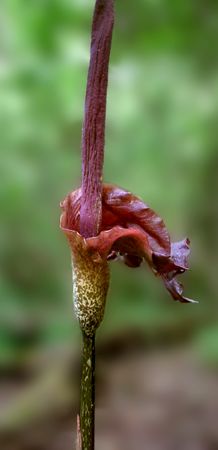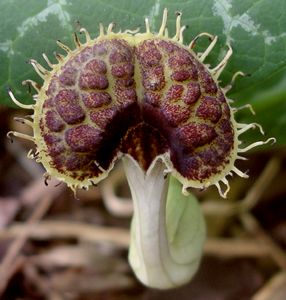
voodoo plant in Florida
 voodoo plant in Florida |
But back to more pleasant nasal associations. When I think of the smells of flowers, my favorites come to mind: lily-of-the-valley, lilac, heirloom roses, Mexican plum, four-o'clocks, Texas mountain laurel, wisteria, Chinese parasol tree. Some flowers are subtle, like the tiny kidneywood blooms or the fluffy pink tufts on mimosa trees. Others are odd, like chocolate flower (yes, it really smells like that) or the sickly sweet loquat blossoms that appear on our trees in December.
As much as we might like to think otherwise, the fragrance produced by a flower is not primarily for our benefit. Flowers evolved for the sole purpose of assisting in plant sex. The chemical compounds that tickle the receptors in animals are a lure to make those creatures, which are far more mobile than plants, deliver pollen from one flower to another. Whether it is a bee, moth, fly, or bat, the flower advertises its reward of nectar with a signal that can travel long distances on a breeze. Once the target has arrived, there are myriad ways in which the male pollen ends up on the creature, with the final intention being that it later gets rubbed off onto a receptive female flower part. The system works admirably; one need only look around at the diverse angiosperms and pollinators that abound in terrestrial habitats.
A rule in nature is that no niche is left unfilled. There are lots of insects, and they don't all have the same preferences when it comes to what smells appeal. While our anthropocentric view of things puts vibrant, warm, sunny places on a pedestal and relegates drab, cold, dark ones to, well, the basement, many life forms inhabit both extremes. There are plants that grow low to the ground instead of reaching for the sky. Others get a jump on competition by starting their annual growth cycle when it is still too cold for most species. And some have adapted to living in the shadows of others. With this much variety in the floral world, it is no surprise that the animals engaged by different species of plants will include some with tastes unlike our own. Some plants need not produce odors at all; those pollinated by birds and some insects during the day need only display bright colors to visually guide them to their treasure. Many nocturnal flowers are white AND have a strong fragrance. These are intended to entice moths, bats or other creatures of the night. Then there are some blossoms with smells so rancid that they seem profane to our delicate sensibilities.
Perhaps the best known native stinky flower is that of skunk cabbage. The name says it all. People from Texas will wonder what I'm talking about, as this plant doesn't grow here. It is found in the northeast U.S. and has some interesting adaptations for thriving in its wet, wooded environment. One of the earliest plants to bloom, skunk cabbage pushes flower spikes up through the ice near ponds and streams before any leaves grow. The plant actually produces heat, as well as a distinctly skunky odor. The main insects that pollinate these pioneer plants are cold hardy, but they certainly take advantage of the higher temperature within the hooded flowers. Flies and beetles are generally a bit more cold-tolerant than bees, and these same insects are often attracted to carrion or other fetid substances.
In spite of its putrid smelling flowers, carrion plants are popular potted succulents. There are a number of different species that all have star-shaped flowers (and are sometimes called starfish flowers). They are pretty but have a nasty odor, much like rotting flesh. The smell is paired with visual signals mimicking a dead animal: hairy, rubbery texture with a deep maroon center that looks like a fatal wound. These features attract flies like crazy, but the plants do not waste resources to reward the insects with nectar. The odor is enough to lure the flies, which mill about and even lay eggs, before losing interest and heading off for the next flower. Once the fly eggs hatch, the maggots will either starve or become food for predators.
 skunk cabbage in Wisconsin |  pipevine in Texas |  blow flies on carrion plant |
Another popular ornamental plant catering to more unusual pollinators is the pipevine. There are a number of different species, and one that does well in our gardens is Aristolochia fimbriata. This low-growing plant makes a nice ground cover, provides food for the lovely pipevine swallowtail caterpillars, and has some of the strangest flowers imaginable. They are quite small, so the odor is not particularly noticeable, and the blossoms often are completely hidden under the leaves. Obviously, no bee or butterfly is going to find them there! Yet flies and beetles, which don't mind mucking about in dark places, find them quite attractive. The reddish color helps too. The "tentacles" that surround the flower add a surrealistic touch to an already bizarre blossom.
The corpse plant, a humungous arum that takes pride of place in major botanical garden greenhouses, is probably the most famous AND the smelliest of the lot. It's sheer size alone means it can produce plenty of rank aroma. For those who want to experience this sort of flower without fighting the crowds at a conservatory, there is a more common relative: the voodoo plant (Typhonium venosum) that naturalizes in the southern states. In the spring, before the leaves emerge, this plant produces a 5-foot tall flower spike that smells like dog poop or something that died awhile back. Once again, the intended pollinators are flies and beetles rather than typical sun-loving bees. This past April, I saw a number of these flowers at Kanapaha Gardens in Gainesville, FL. Their scent announced their presence long before I managed to see them growing under a thick tree canopy. I'll admit that I took my photos quickly in order to leave the area before feeling too nauseous. I am glad I didn't have our dog, Peri, with me because I'm sure she would have been uncontrollably ecstatic in the presence of such canine-catnip. I guess fragrance is all in the nose of the inhaler.